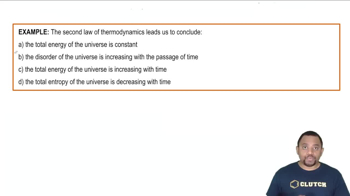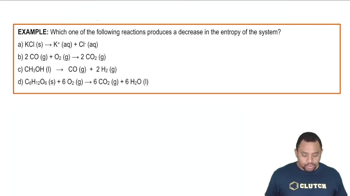Here are the essential concepts you must grasp in order to answer the question correctly.
Entropy
Entropy is a measure of the disorder or randomness in a system. In thermodynamics, it quantifies the number of microscopic configurations that correspond to a thermodynamic system's macroscopic state. Higher entropy indicates greater disorder and less energy available for doing work, reflecting the second law of thermodynamics, which states that the total entropy of an isolated system can never decrease over time.
Recommended video:
Entropy in Thermodynamics
Second Law of Thermodynamics
The second law of thermodynamics states that in any energy transfer or transformation, the total entropy of an isolated system will always increase over time. This principle implies that natural processes tend to move towards a state of greater disorder or randomness. It explains why certain processes, such as heat transfer from hot to cold objects, occur spontaneously, leading to an increase in the overall entropy of the universe.
Recommended video:
Second Law of Thermodynamics Example
Example of Increasing Entropy
An example of a process in which entropy increases is the melting of ice into water. When ice melts, the structured arrangement of water molecules in the solid state becomes more disordered in the liquid state. This transition from a solid to a liquid increases the entropy of the system, as the molecules have more freedom to move and occupy a greater number of configurations.
Recommended video:
Entropy and Chemical Changes Example
 McMurry 8th Edition
McMurry 8th Edition Ch.18 - Thermodynamics: Entropy, Free Energy & Equilibrium
Ch.18 - Thermodynamics: Entropy, Free Energy & Equilibrium Problem 42
Problem 42 Verified step by step guidance
Verified step by step guidance


